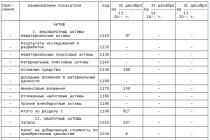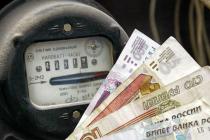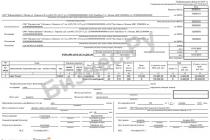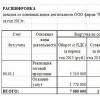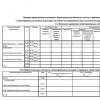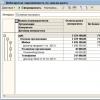At the legislative level, tax inspectorates require individual entrepreneurs to submit reports on their income within specially established deadlines. However, in some companies registered as sole proprietorships, there may be a temporary lack of profit. For these cases, a special procedure is provided for informing the Federal Tax Service about the available funds, which consists in drawing up a zero declaration.
The profit of the enterprise is reflected in the declaration of income. Submission of such a document is a mandatory procedure for all entrepreneurs, regardless of the amount of income and its presence or absence. To minimize the risk of problems with the FTS, reports should be submitted in a timely and consistent manner.
In the absence of earnings, this type of documentation is changed and a zero declaration is drawn up. It documents the fact of the existence of an individual enterprise, while indicating that there is no cash flow in the company's accounts, and therefore there are temporarily no funds to pay the tax.
The zero declaration is not allocated to a special type of relevant documentation - an ordinary report is submitted in the form of 3-NDFL, in the columns of which the absence of profit is indicated. Reports of individual enterprises reflecting the financial picture related to value added tax (VAT) are widespread.
Who and in what cases can file a declaration with the Federal Tax Service?
This document is provided for any kind of IP activity. It does not matter and the reason for the lack of income. Usually a zero declaration is submitted by entrepreneurs if:
- the company did not receive any profit during the reporting period;
- there were losses in the IP for the period presented;
- there was no work of the enterprise;
- there is no staff in the IP;
- IP activities began, but soon the company was liquidated.
In case of submission of a zero VAT declaration, the list expands:
- The individual entrepreneur made financial transactions during the reporting period that are not subject to VAT (sections 1 and 3 of the declaration);
- non-taxable activities were carried out (sections 1, 2, 7);
- income is represented by a partial advance payment against the forthcoming delivery, the products from which are manufactured for more than six months;
- An individual entrepreneur who does not pay VAT issues invoices (sections 1, 2, 12);
- services or goods are sold outside the Russian Federation (sections 1, 7).
Do I need to pay taxes in this case?
The legislation provides for two types of payment of deductions for individual entrepreneurs - the payment of taxes on income and payments on residual funds. In the first case, in the absence of cash flow, there is no need to pay deductions to the Federal Tax Service. If the company makes payments under the scheme of the difference between income and expenses, the entrepreneur will in any case have to pay a tax of 1% of the profit.
Specificity of the representation of the null declaration
There are 3 types of tax regime - general and simplified taxation systems, a single tax on imputed income. You can familiarize yourself with the forms of these declarations and samples for filling them out at the link below.
Under the general system of taxation
An entrepreneur is automatically registered for this type of taxation, if he did not declare the use of other types of payments. In the absence of the company's activity, at the end of the quarterly period, zero declarations for VAT and 3-NDFL are submitted. The first - four times a year until the 25th day of the month following the reporting month, the second - once a year no later than the 30th day when registering funds for the previous year.
Single simplified declaration
If during the reporting period the company was not liquidated, but there was no activity on it, the head for the quarter can submit another type of document instead of a zero VAT and income tax return - EUD. Usually, simplified declarations of a single sample are submitted in paper form. This is especially convenient for newly appeared individual entrepreneurs who did not have time to establish electronic communication channels and start doing business.
The IFTS accepts this type of document on simplified terms: the EUD can be submitted both by an individual entrepreneur or the head of an organization, and by an authorized person (representative of an individual entrepreneur). You can submit a declaration by state mail with an inventory or through a channel that transfers zero VAT returns for individual entrepreneurs.
The EUD is submitted the next month after the end of the reporting period no later than the 20th day - the deadline for submitting such a document is shorter than that for VAT returns.
Under the UTII system
In practice, zero reporting for imputed income tax does not occur, since under such a regime, entrepreneurial activity must be carried out. If this does not happen, the company from the next reporting period switches to a simplified taxation system. In other cases, the procedure for filing declarations of this type does not differ from the usual one.
Features of applying the zero VAT rate
When receiving a zero VAT rate, the taxpayer must submit documentation that confirms the validity of this decision. Tax legislation provides for a number of cases in which a zero VAT rate is applied. These include:
- situations when products are exported;
- application of international transportation services;
- implementation of services in the space industry;
- activities related to the sale of precious metals;
- Passenger Transportation.
A complete list of services can be found in Article 164 of the Tax Code of the Russian Federation.
To obtain the right to apply the zero VAT rate, the following documents are required when exporting:
- Copy and original of the export contract with an extract from it. This type of document is issued with a company located abroad and allows the export of goods outside the single customs zone.
- Copy or original of the customs declaration. The document must be marked by the customs office that allowed the export release of the goods from the Russian Federation, as well as the border structure from which the goods were released with registration of their departure and transportation. If the product was exported abroad from a place where customs clearance was canceled, the stamp of the department that made this registration must be stamped.
- Copies or originals of the transport documentation attached to the customs declaration. The type of documentation depends on the vehicle by which the goods are supposed to be exported outside the Russian Federation. The papers must be stamped by authorities confirming the right to export these products.
When exporting goods, the required documentation must be collected within 180 days from the date of registration at customs, otherwise VAT will be at a general rate of 10% (applies to scientific and educational literature, periodicals, medicines, children's things and some foodstuffs) or 18% ( the most common percentage).
IMPORTANT: If the right to receive a zero VAT rate is not confirmed within the prescribed period, the head of the IP has the right to deduct the amount of input VAT. The date of drawing up the primary document in the name of the buyer of the exported goods is recognized as the date of shipment of the products. Other documentation prescribed by law or an extract from it (for example, agreements with customs) has a similar force.
Upon submission of a full package of documents, the amount paid as a tax can be returned within a three-year period. However, fines and penalties paid together with VAT are non-refundable.
If the supplier enjoys an input VAT deduction, then these funds used for export transactions should be considered separately from the amounts of input taxes on transactions that are taxed at different rates. If the right to receive zero VAT is not exercised, exporters should:
- make a conversion of the proceeds into ruble currency at the current exchange rate of the Central Bank at the time of shipment;
- fix invoices: instead of zero VAT, depending on the exported products, a rate of 10% or 18% is used;
- for the period when the goods were shipped for export, register the corrected invoice in the quarterly sales book, indicate the date of the adjustment;
- during the time of shipment of the product, issue a new invoice issued by the supplier in the sales book for the quarter;
- submit an updated VAT return for the period in which the goods were exported.
In case of non-confirmation of the zero VAT rate, a fine is imposed on exporters. The zero VAT rate cannot be applied if the exported goods of one Russian company are sold by another Russian company.
Instructions for filling
The declaration of the type 3-NDFL reflects the annual expenses, advances and tax deductions of the individual entrepreneur. In the absence of these data, the corresponding columns are reset to zero.
If an individual entrepreneur is liquidated, the entrepreneur must, within five working days, make a zero tax return. The procedure is carried out when the closing of the company falls in the middle of the quarterly period. 
The report is submitted at the place of residence of the entrepreneur, where he is registered as a payer of the DOS tax. The name of the individual entrepreneur must be documented.
There are no numbers for the calculation for the zero VAT return in the IP, so this type of document is easier to fill out. When submitting a declaration for value added tax (in accordance with the Order of the Federal Tax Service No. MMV-7-3 / 588, Appendix 1), you must fill out the title page and the first section. Mostly this type of design is used in the absence of IP activity. The rest of the sections are optional.
In those columns of the document that are to be filled in, numerical or alphabetic values are entered starting from the first cell. In cells that are not required to be filled out, a dash should be put (in accordance with Appendix 2 of the above Order). In prices, penny amounts are rounded up: if the balance is less than 50 kopecks, it is rounded down, if it is larger, it is rounded up.
The zero declaration must contain a fully completed title page with the correct values of KPP, OKTMO and TIN in the first section. Both parts of the document are signed by the entrepreneur indicating the date of compilation.
First leaf
On the first page, the organization's data is indicated - it is important to fill in all the columns correctly in order to avoid problems when calculating taxes. Values are entered in the following forms:
- Checkpoint (TIN). For individual entrepreneurs, the full name of the head is prescribed. The number of the Federal Tax Service of the site where the company is registered is also filled in (indicated in the documents of registration of the enterprise). The codes "at the location / registration" are given in the third Appendix to the procedure for filling out the declaration.
- Correction number. At the first submission of the declaration of zero profitability, the adjustment number is entered as "0". Serial numbers are affixed in the subsequent clarifying documentation.
- Report year.
- Taxable period. One of the codes given in the third Appendix is affixed. If the report is submitted for the 1st quarter of the year, the number 21 is entered, if the company is liquidated - 51.
- IFTS. The name of the department of the Federal Tax Service for the area of registration of IP is indicated.
- OKVED. For a zero declaration, OKVED is entered in accordance with the codes presented in the unified register of individual entrepreneurs. Also, the coding of activities can be viewed in the unified state classifier.
- The name of the individual enterprise. On the same page, in a specially designated place, the seal of the individual entrepreneur, the position of the compiler, the signature of the entrepreneur with a transcript, as well as the date of the declaration are affixed. The title page indicates the total number of pages in the document.
Second sheet
On the second sheet, line 001 indicates the type of tax collection object (1 - from income, 2 - from the difference between income and expenses).
Column 010 is entered into the OKATO line and means OKTMO. You can find it on the pages of the website of the Federal Migration Service or Rosstat.
The budget classification code is entered in line 020.
Lines 030-050 contain dashes or zeros (dashes may not be recognized correctly by some programs).
Columns from 060 to 080 are to be filled in if the value 227 is on the main sheet in the line “at the location”.
The remaining columns, when submitting a zero declaration, remain blank - crossed out.
Third sheet
On the third sheet, only one column is entered - 201. It indicates the tax rate (when taxing income - 6%, the difference between income and expenses - 15%). The rest of the lines are dashed.
On each of the sheets, the date and signature of the head of the IP with a transcript are noted.
IMPORTANT: Sections 8 and 9 contain information on invoices (when filing a zero VAT return, these fields may be required). If the entrepreneur does not pay VAT, but has drawn up an invoice, he will have to complete section 12.
Reporting
Timing
The deadlines for submitting an income statement to the Federal Tax Service are established by Article 229 of the Tax Code of the Russian Federation. So, in the case of an individual entrepreneur, it is required to draw up a declaration annually no later than the 25th day of the month that follows the expiring reporting period. If the date is a non-working date or falls on a weekend, the deadline is the first business day from that date.
When submitting a document after the prescribed time, the tax office has the right to fine the entrepreneur. The amount of the fine can vary and range from 1,000 rubles to 30% of the amount to be paid to the Federal Tax Service. In some cases, the amount is reduced - for example, less funds may be collected in case of a short delay in submitting a report.
However, if the fine is collected through the courts, in most cases a decision is made in favor of the head of the IP with a rejection of the tax requirement to impose a fine, since the company does not have the funds to pay deductions.
How to file a declaration
Enterprises that pay VAT send zero declarations in electronic format. For this purpose, a specialized telecommunications channel is provided, which is controlled by the operators-employees of the Federal Tax Service. If the document is submitted in any other form (even if a paper sample is sent by mail with an inventory), the declaration is considered not submitted and is rejected. This can lead to the freezing of individual bank accounts.
Conclusion
The zero declaration is a special case of an ordinary document certifying the income of an individual entrepreneur for the reporting quarter. Profit is recorded in the form of a 3-personal income tax form. When requesting a zero VAT rate for export, the entrepreneur must submit documents that certify the legality of the cancellation of standard payments.
Submission of declarations to the tax office, even in the absence of income, is a mandatory procedure for every open IP. Failure to comply with this rule will result in penalties.



